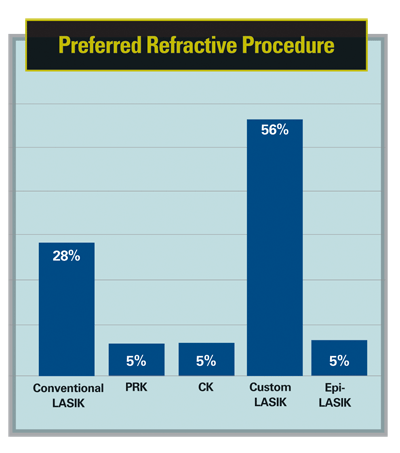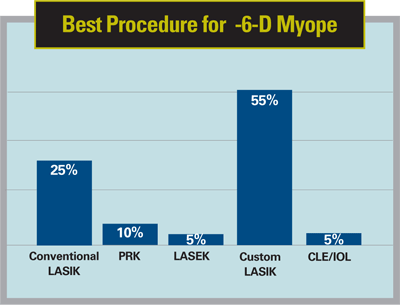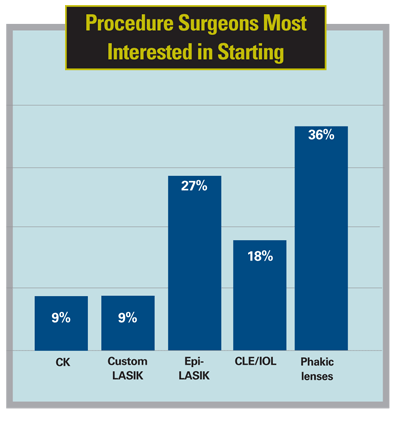For this month's Panel Report on refractive surgery, 31 surgeons, or 6 percent of the 500-surgeon sample, responded. Here are their thoughts.

LASIK Roundup
Custom LASIK is the surgery 56 percent of the panelists say they use for most of their refractive procedures, followed by conventional LASIK, which was chosen by 28 percent. PRK, conductive keratoplasty and epi-LASIK were each chosen by 5 percent of the respondents.
Sixty-nine percent of the custom LASIK users say the results are somewhat better when compared to conventional LASIK, 13 percent feel they're significantly better and 19 percent think they're the same.
Frank Rosenbaum, MD, of Lansing, Mich., says that custom's results are better, but that he doesn't like having to "explain the difference between conventional and custom to patients." Sidney Seltzer, MD, of Charleston, S.C., likes custom procedures because they "produce better quality of vision."
New York City's Harvey Rosenblum, MD, agrees, saying, "They give the ability to achieve higher levels of visual acuity." For Paramus, N.J., ophthalmologist Douglas Liva, the benefits of wavefront-guided procedures don't only appear on the Snellen chart. "The patients have low night-vision disturbances," he avers.
But not all the surgeons think custom LASIK is without flaws. "With custom, it's difficult to fine-tune the nomogram for astigmatism and monovision treatment," says a Delaware doctor. A surgeon from New Jersey thinks that custom results are equivalent to conventional, but that performing custom LASIK "increases my costs and takes more time." Steward Shofner, MD, of Nashville, likes custom's results, but states he gets "overcorrections in 10 percent of the patients." Michael Solomon, DO, of Warren, Mich., adds, "It's not the holy grail!"
Most of the respondents, (59 percent) perform five to 20 LASIK cases per month, 17 percent perform 21 to 50, 5 percent do between 76 and 100, and 17 percent perform over 100. The average price they charge per eye is $2,169, and they charge an average of $269 more per eye for custom compared to conventional. The average LASIK facility fee they pay is $647 per eye.
Though LASIK is still the most popular procedure, respondents say the risk of ectasia has somewhat chilled their attitude toward it. Fifty-eight percent say the extra attention being paid to ectasia has affected the way they approach potential LASIK patients.
"I stay away from abnormal topography," says Charleston's Dr. Seltzer. A surgeon from New Jersey feels the same way, saying, "I avoid patients with thinner pachymetry and/or suspicious topography maps." A surgeon from New York says that for some patients with suspicious presentations and preop data, he "won't perform the procedure, or will refer the patients elsewhere."
Dr. Solomon spends more time with LASIK patients' exam findings. "I scrutinize their topography using more parameters," he says.
Several surgeons have responded to the risk of ectasia by doing more surface procedures. "I recommend surface ablation to certain patients," says Robert Gerald, MD, of Amarillo, Texas.
"I do PRK more often now," says Nashville's Dr. Shofner.

Focusing on Lenses
A third of the respondents have implanted at least one phakic intraocular lens, and several weighed in on what they like and don't like about the new technology. "One has to choose the patients carefully for phakic lenses," says Princeton, N.J., surgeon Boonlua Ratanawongsa. "They must have realistic expectations." "The quality of vision is excellent," says Dr. Rosenbaum. "However, there's a worry of future cataract formation with the Visian, which I use."

Dr. Seltzer would like to see the phakic lens offerings widen a little. "The Visian is only spherical," he says. "We need a toric."
Dr. Solomon says that phakic lenses can be a tough sell for patients, however. "Patients don't like the extra costs when compared to LASIK," he says.
Sixty-three percent of the panelists implant at least one of the three currently available presbyopic IOLs (Alcon's ReStor, AMO's ReZoom and Eyeonics' Crystalens) for refractive clear-lens exchange (i.e., not just for cataract). Thirteen percent say they don't implant any of these new lenses now, but plan to.
The Ideal Procedures
The surgeons also had opinions on what would be the best procedure for the following patient presentations:
• -3 D myope. Sixty percent of the surgeons would choose custom LASIK for this patient, 30 percent like conventional LASIK and 10 percent would do PRK. "Custom LASIK gives reproducible, stable results," says Dr. Shofner.
• -6 D myope. Fifty-five percent prefer custom LASIK for this patient, a quarter like conventional LASIK and 10 percent would do PRK. LASEK and clear-lens extraction were each selected by 5 percent of the panelists. "LASEK is safer, with no worry of ectasia," says a surgeon from New York. "History dictates that advanced surface ablation such as PRK/LASEK is the best approach in this patient."
• -11 D myope. Here, surgeons start to make the shift to preferring lenticular procedures, with 73 percent favoring a phakic lens, 23 percent preferring clear-lens extraction and 4 percent saying they'd do PRK. "A phakic IOL is effective and is probably safer than LASIK," says an Indiana surgeon.
• +2 D hyperope. LASIK remains popular for the low hyperope, with 69 percent of surgeons choosing it. Thirteen percent of the respondents say they'd perform PRK, and another 13 percent prefer CK. Six percent would do a clear-lens extraction/IOL implantation. "LASIK is fairly predictable in these patients," says Dr. Solomon.
• 45-year-old myopic presbyope. Forty-two percent of surgeons would do LASIK monovision, 26 percent like bifocals and 16 percent like multifocal contact lenses. Contact-lens monovision, CK monovision and the ReStor presbyopic implant were each chosen by 5 percent of the surgeons. Dr. Seltzer's first choice in such as case is a pair of bifocals. However, he adds that, "I only change this approach if the patient wants surgery. Then it's clear-lens extraction/IOL implantation."




